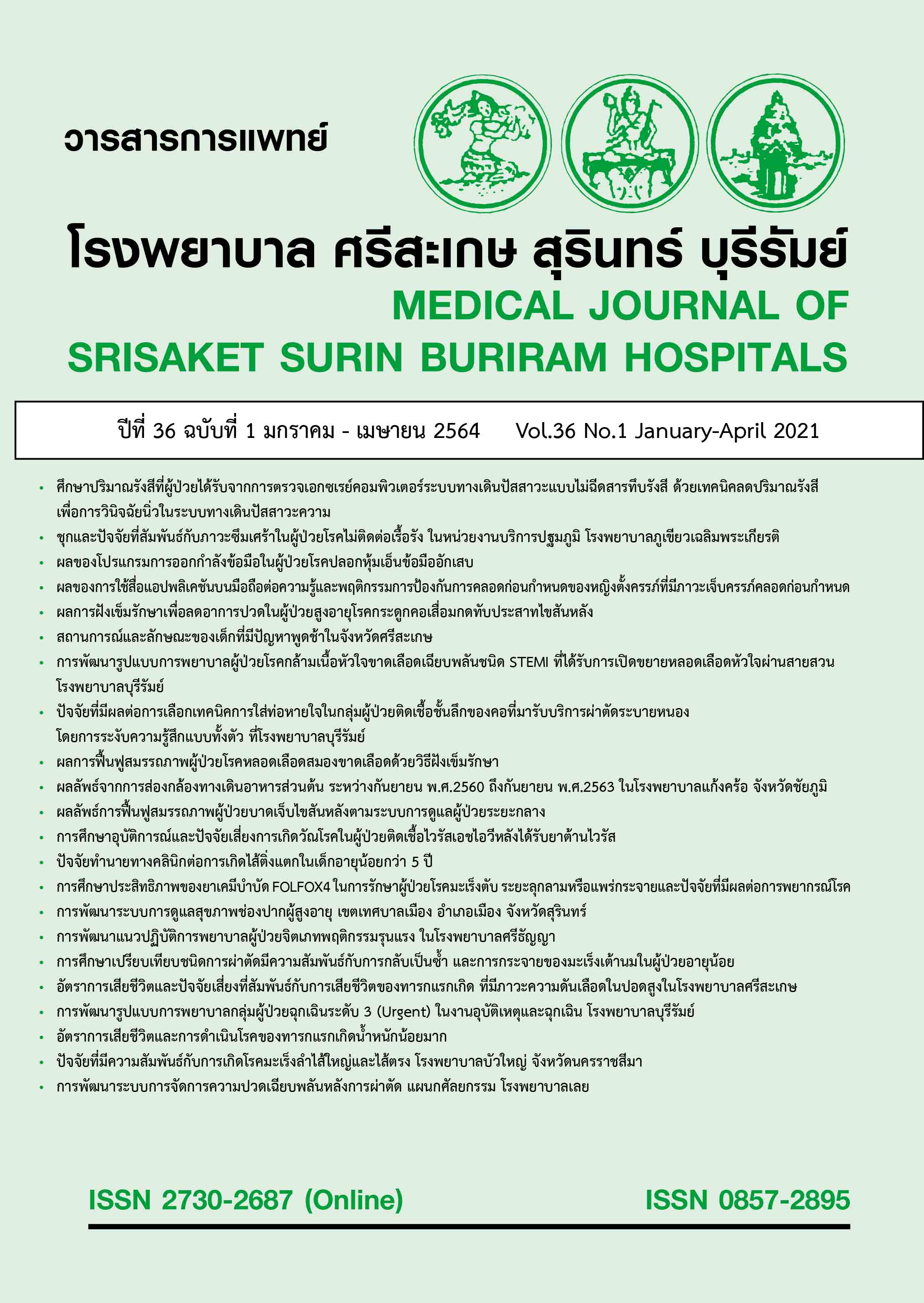ผลการฝังเข็มรักษาเพื่อลดอาการปวดในผู้ป่วยสูงอายุโรคกระดูกคอเสื่อมกดทับประสาทไขสันหลัง
Main Article Content
บทคัดย่อ
หลักการและเหตุผล: โรคกระดูกคอเสื่อมกดทับประสาทไขสันหลัง พบได้บ่อยในผู้สูงอายุมีสาเหตุเกิดจากความผิดปกติที่ไขสันหลังอาจจะไม่มีอาการหรืออาจมีอาการรุนแรง อาการทางคลินิกที่พบ ได้แก่ อาการปวดคอ ไหล่ แขนเรื้อรัง ส่งผลต่อการดำเนินชีวิตประจำวัน การฝังเข็มรักษาเพื่อลดอาการปวดสามารถใช้ลดความปวดเรื้อรังได้ทุกชนิด
วัตถุประสงค์: เพื่อศึกษาผลการฝังเข็มรักษาเพื่อลดอาการปวดในผู้ป่วยสูงอายุโรคกระดูกต้นคอเสื่อมกดทับประสาทไขสันหลัง
วิธีการศึกษา: การศึกษาย้อนหลังในผู้ป่วยโรคกระดูกคอเสื่อมกดทับประสาทในโรงพยาบาลชัยภูมิ ระหว่าง วันที่ 1 ตุลาคม พ.ศ. 2558 - วันที่ 30 เมษายน พ.ศ. 2563 จำนวน 180 ราย วิเคราะห์ข้อมูล โดยใช้ Chi-square test, Fisher exact test และ odds ratio with 95% confidence interval ข้อมูล Continuous ใช้ Independent sample t-test (p-value<0.05) และใช้ Independent pair t-test ทดสอบความแตกต่างค่าเฉลี่ยของคะแนนจากการประเมินความปวด (Pain scale) ก่อนและหลังการรักษาภายในกลุ่มที่ p-value <0.05
ผลการศึกษา: ผู้ป่วยโรคกระดูกคอเสื่อมกดทับประสาทไขสันหลัง และมีผล Magnetic Resonance Imaging (MRI) จำนวน 70 ราย เพศชายร้อยละ 54.3 อายุเฉลี่ย 67.2±6.3 ปี ระยะเวลาเจ็บป่วยเฉลี่ย 13.5±13.8 เดือน ประกอบอาชีพเกษตรกรรม ร้อยละ 30 ดัชนีมวลกายเฉลี่ย 23.3±4.0 กิโลกรัม/ตารางเมตร อาการทางคลินิกที่ตรวจพบมากได้แก่ Neck pain ร้อยละ 61.4, Weakness of arms / hands ร้อยละ 61.4 Headache ร้อยละ 45.7 Stiffness neck ร้อยละ 42.9 และ Ataxia ร้อยละ 34.3 โรคร่วมและโรคประจำตัวที่พบได้แก่ Diabetes mellitus ร้อยละ 32.9 Rheumatoid arthritis ร้อยละ 24.3 และ Hypertension ร้อยละ 12.9 ความรุนแรงของโรคโดยใช้ nurick’s scale พบว่า Grade 2 ร้อยละ 31.4 Grade 3 ร้อยละ 28.6 ปัจจัยเสี่ยงที่มีความสัมพันธ์กับการเกิดโรคคือ อายุ 60-65 ปี (OR, 0.5 ; 95% CI,0.3-0.9) ส่วนปัจจัยอื่นพบว่าไม่มีนัยสำคัญทางสถิติการเปรียบเทียบค่าเฉลี่ยคะแนนความปวดก่อนและหลังการฝังเข็มรักษา 3 เดือนด้วยสถิติ Independent pair t-test จากแบบประเมินความปวด Thai Short-form McGill Pain Questionnaire (TH-SF-MPQ) พบว่าอาการปวดก่อนและหลังการรักษามีความแตกต่างกันอย่างมีนัยสำคัญทางสถิติ (p-value 0.05)
สรุป: การฝังเข็มรักษาในผู้ป่วยสูงอายุโรคกระดูกคอเสื่อมกดทับประสาทไขสันหลังเพื่อลดอาการปวด คอ ไหล่ แขน และสามารถลดอาการปวดเรื้อรังได้อย่างมีประสิทธิผล
คำสำคัญ: โรคกระดูกคอเสื่อมกดทับประสาทไขสันหลัง ผู้ป่วยสูงอายุ การฝังเข็มรักษา
Article Details
เอกสารอ้างอิง
Hashish R, Badday H. Frequency of acute cervical and lumbar pathology in common types of motor vehicle collisions: a retrospective record review. BMC Musculoskelet Disord 2017;18(1):437. doi: 10.1186/s12891-017-1797-5.
Ahn NU, Ahn UM, Amundson GM, An HS. Axial-mechanical neck pain and cervical degenerative disease. The Adult and Pediatric Spine 3rd.ed. Philadelphia: Lippincott Williams & Wilkins; 2004:671-87.
McDonnell M, Lucas P. Cervical spondylosis, stenosis, and rheumatoid arthritis. Med Health R I 2012;95(4):105-9. PMID: 22712188
Rao RD, Currier BL, Albert TJ, Bono CM, Marawar SV, Poelstra KA, et al. Degenerative cervical spondylosis: clinical syndromes, pathogenesis, and management. J Bone Joint Surg Am 2007;89(6):1360-78. doi: 10.2106/00004623-200706000-00026.
Luo BH, Han JX. Cervical spondylosis treated by acupuncture at Ligou (LR 5) combined with movement therapy. J Tradit Chin Med 2010;30(2):113-7. doi: 10.1016/s0254-6272(10)60025-8.
Emery SE. Cervical spondylotic myelopathy: diagnosis and treatment. J Am Acad Orthop Surg 2001;9(6):376-88. doi: 10.5435/00124635-200111000-00003.
Lee MJ, Cassinelli EH, Riew KD. Prevalence of cervical spine stenosis. Anatomic study in cadavers J Bone Joint Surg Am 2007;89(2):376-80. doi: 10.2106/JBJS.F.00437.
Binder AI. Cervical spondylosis and neck pain. BMJ 2007;334(7592):527-31. doi:10.1136/bmj.39127.608299.80.
Wang B, Liu H, Wang H, Zhou D. Segmental instability in cervical spondylotic myelopathy with severe disc degeneration Spine (Phila Pa 1976) 2006 May 20;31(12):1327-31. doi: 10.1097/01.brs.0000218508.86258.d4.
Albert TJ, Murrell SE. Surgical management of cervical radiculopathy. J Am Acad Orthop Surg. 1999 ; 7:368–76.
Kadanka Z, Mares M, Bednaník J, Smrcka V, Krbec M, Stejskal L, et al. Approaches to spondylotic cervical myelopathy: conservative versus surgical results in a 3-year follow-up study. Spine (Phila Pa 1976) 2002;27(20):2205-10; discussion 2210-1. doi: 10.1097/01.BRS.0000029255.77224.BB.
Astin JA, Marie A, Pelletier KR, Hansen E, Haskell WL. A review of the incorporation of complementary and alternative medicine by mainstream physicians. Arch Intern Med 1998;158(21):2303-10. doi: 10.1001/archinte.158.21.2303.
White A, Hayhoe S, Hart A, Ernst E. Adverse events following acupuncture: prospective survey of 32 000 consultations with doctors and physiotherapists. BMJ 2001;323(7311):485-6.doi: 10.1136/bmj.323.7311.485.
MacPherson H, Thomas K, Walters S, Fitter M. The York acupuncture safety study: prospective survey of 34 000 treatments by traditional acupuncturists. BMJ 2001;323(7311):486-7. doi: 10.1136/bmj.323.7311.486.
Melchart D, Weidenhammer W, Streng A, Reitmayr S, Hoppe A, Ernst E, et al. Prospective investigation of adverse effects of acupuncture in 97 733 patients. Arch Intern Med 2004;164(1):104-5. doi: 10.1001/archinte.164.1.104.
Melzack R, Wall PD. Pain mechanisms: a new theory . Science 1965;150(3699):971-9. doi: 10.1126/science.150.3699.971.
Siegele DS. Pain and suffering. The gate control theory. Am J Nurs 1974 ;74(3):498-502. PMID: 436102717.
Melzack R, Katz J. Pain measurement in persons in pain. In: Wall PD, Melzack R, eds. Textbook of pain London: Harcourt Publisher; 1999: 409-26.
Kitisomprayoonkul W, Klaphajone J, Kovindha A. Thai short-form McGill pain questionnaire. J Med Assoc Thai 2006;89(6):846-53. PMID: 16850687
Kelsey JL, Whitemore AS, Evans AS, Thomson WD. Methods in Observational Epidemiology. 2nd. ed. Oxford: Oxford University Press; 1996.
Nurick S. The pathogenesis of the spinal cord disorder associated with cervical spondylosis. Brain 1972;95(1):87-100. doi: 10.1093/brain/95.1.87.
Takamiya Y, Nagata K, Fukuda K, Shibata A, Ishitake T, Suenaga T. Cervical spine disorders in farm workers requiring neck extension actions. J Orthop Sci 2006;11(3):235-40. doi: 10.1007/s00776-006-1005-1.
Yue WM, Tan SB, Tan MH, Koh DC, Tan CT. The Torg--Pavlov ratio in cervical spondylotic myelopathy: a comparative study between patients with cervical spondylotic myelopathy and a nonspondylotic, nonmyelopathic population. Spine (Phila Pa 1976) 2001;26(16):1760-4. doi: 10.1097/00007632-200108150-00006.
Lebl DR, Bono CM. Update on the Diagnosis and Management of Cervical Spondylotic Myelopathy. J Am Acad Orthop Surg 2015;23(11):648-60. doi: 10.5435/JAAOS-D-14-00250.
Fu WB, Liang ZH, Zhu XP, Yu P, Zhang JF. Analysis on the effect of acupuncture in treating cervical spondylosis with different syndrome types. Chin J Integr Med 2009;15(6):426-30. doi: 10.1007/s11655-009-0426-z.
Zhu J, Arsovska B, Kozovska K, Nikolovska K. Acupuncture in the treatment of pain JSIR 2017;6(1):16-18.
Chinese Acupuncture & Herb Center. Acupuncture and Traditional Chinese Medicine to Heal Chronic and Acute Pain. [Internet]. [cited 2021 Jan 15]. Available from:URL: https://www.chineseacupunctureherbcenter.com/
Wilkinson J, Faleiro R. Acupuncture in pain management. CEACCP 2007;7(4):135-8.
Itoh K, Katsumi Y, Hirota S, Kitakoji H. Randomised trial of trigger point acupuncture compared with other acupuncture for treatment of chronic neck pain. Complement Ther Med 2007;15(3):172-9. doi: 10.1016/j.ctim.2006.05.003.
Trinh KV, Graham N, Gross AR, Goldsmith CH, Wang E, Cameron ID, Kay T. Acupuncture for neck disorders. Cochrane Database Syst Rev 2006;(3):CD004870. doi: 10.1002/14651858.CD004870.


